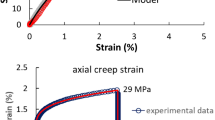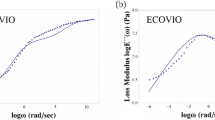Abstract
Strain/stress-controlled loading, loading–unloading, loading-relaxation (or creep), and corresponding cyclic tests are essential for characterizing the viscoelastic materials' rate-dependent stress–strain relationship. A three-parameter model is proposed based on the basic definition of fractional derivative viscoelasticity and time-varying viscosity. This model is applied to many complex loading conditions. The solutions for three monocyclic loading conditions are given and then further generalized to arbitrary linear loading conditions, which are assumed to be first-order functions of time. The generalized solution for the arbitrary linear loading path is validated by modelling the mechanical response of cyclic loading–unloading and loading–relaxation (or creep) tests. Four sets of experimental data for polymer materials are employed to demonstrate the proposed fractional derivative model's efficiency. The results show that it can accurately model strain/ stress-controlled response under various loading conditions using only three parameters. The model is then implemented in numerical software to explore its capacity further, and the simulation results show that it also succeeds in simulating cyclic loading–unloading tests.








Similar content being viewed by others
References
Haupt, P.: On the mathematical modelling of material behavior in continuum mechanics. Acta Mech 100, 129–154 (1993). https://doi.org/10.1007/BF01174786
Truesdell, C., Noll, W.: The Non-Linear Field Theories of Mechanics, 3rd edn. Springer-Verlag, Berlin Heidelberg (2004). https://doi.org/10.1007/978-3-662-10388-3
Zhang, C., Moore, I.D.: Nonlinear mechanical response of high density polyethylene Part II Uniaxial constitutive modeling. Polym. Eng. Sci. 37(1997), 414–420 (1997). https://doi.org/10.1002/pen.11684
Brusselle-Dupend, N., Lai, D., Feaugas, X., Guigon, M., Clavel, M.: Mechanical behavior of a semicrystalline polymer before necking Part II Modeling of uniaxial behavior. Polym. Eng. Sci. 43(2003), 501–518 (2003). https://doi.org/10.1002/pen.10041
Lai, D., Yakimets, I., Guigon, M.: A nonlinear viscoelastic model developed for semi-crystalline polymer deformed at small strains with loading and unloading paths. Mater. Sci. Eng. A. 405, 266–271 (2005). https://doi.org/10.1016/j.msea.2005.06.011
Zrida, M., Laurent, H., Rio, G., Pimbert, S., Grolleau, V., Masmoudi, N., Bradai, C.: Experimental and numerical study of polypropylene behavior using an hyper-visco-hysteresis constitutive law. Comput. Mater. Sci. 45, 516–527 (2009). https://doi.org/10.1016/j.commatsci.2008.11.017
Gemant, A.: A method of analyzing experimental results obtained from elasto-viscous bodies. Physics. 7, 311–317 (1936). https://doi.org/10.1063/1.1745400
Blair, G.S., Caffyn, J.E.: VI An application of the theory of quasi-properties to the treatment of anomalous strain-stress relations. Lond. Edinb. Dublin Philos. Mag. J. Sci 40, 80–94 (1949). https://doi.org/10.1080/14786444908561213
Slonimsky, G.L.: Laws of mechanical relaxation processes in polymers. J. Polym. Sci. Part C Polym. Symp. (1967). https://doi.org/10.1002/polc.5070160342
Smit, W., De Vries, H.: Rheological models containing fractional derivatives. Rheol. Acta. 9, 525–534 (1970). https://doi.org/10.1007/BF01985463
Bagley, R.L., Torvik, P.J.: A theoretical basis for the application of fractional calculus to viscoelasticity. J. Rheol. 27, 201–210 (1983). https://doi.org/10.1122/1.549724
Bagley, R.L., Torvik, P.J.: On the fractional calculus model of viscoelastic behavior. J. Rheol. 30, 133–155 (1986). https://doi.org/10.1122/1.549887
Koeller, R.C.: Applications of fractional calculus to the theory of viscoelasticity. J. Appl. Mech. 51, 299–307 (1984). https://doi.org/10.1115/1.3167616
Schiessel, H., Metzler, R., Blumen, A., Nonnenmacher, T.F.: Generalized viscoelastic models: their fractional equations with solutions. J. Phys. Math. Gen. 28, 6567–6584 (1995). https://doi.org/10.1088/0305-4470/28/23/012
Schmidt, A., Gaul, L.: Finite element formulation of viscoelastic constitutive equations using fractional time derivatives. Nonlinear Dyn. 29, 37–55 (2002). https://doi.org/10.1023/A:1016552503411
Jiang, X., Xu, M., Qi, H.: The fractional diffusion model with an absorption term and modified Fick’s law for non-local transport processes. Nonlinear Anal. Real World Appl. 11, 262–269 (2010). https://doi.org/10.1016/j.nonrwa.2008.10.057
Qi, H., Jin, H.: Unsteady helical flows of a generalized Oldroyd-B fluid with fractional derivative. Nonlinear Anal. Real World Appl. 10, 2700–2708 (2009). https://doi.org/10.1016/j.nonrwa.2008.07.008
Xu, H., Jiang, X.: Creep constitutive models for viscoelastic materials based on fractional derivatives. Comput. Math. Appl. 73, 1377–1384 (2017). https://doi.org/10.1016/j.camwa.2016.05.002
Maestro, A., Gonzalez, C., Gutierrez, J.M.: Shear thinning and thixotropy of HMHEC and HEC water solutions. J. Rheol. 46, 1445–1457 (2002). https://doi.org/10.1122/1.1516789
Abu-Jdayil, B.: Modelling the time-dependent rheological behavior of semisolid foodstuffs. J. Food Eng. 57, 97–102 (2003). https://doi.org/10.1016/S0260-8774(02)00277-7
Yang, X., Cai, W., Liang, Y., Holm, S.: A novel representation of time-varying viscosity with power-law and comparative study. Int. J. Non-Linear Mech. 119, 103372 (2020). https://doi.org/10.1016/j.ijnonlinmec.2019.103372
Yin, D., Wu, H., Cheng, C., Chen, Y.: Fractional order constitutive model of geomaterials under the condition of triaxial test: fractional order constitutive model of geomaterials. Int. J. Numer. Anal. Methods Geomech. 37, 961–972 (2013). https://doi.org/10.1002/nag.2139
Buckingham, M.J.: Wave propagation, stress relaxation, and grain-to-grain shearing in saturated, unconsolidated marine sediments. J. Acoust. Soc. Am. 108, 2796–2815 (2000). https://doi.org/10.1121/1.1322018
Pandey, V., Holm, S.: Linking the fractional derivative and the Lomnitz creep law to non-Newtonian time-varying viscosity. Phys. Rev. E. 94, 032606 (2016). https://doi.org/10.1103/PhysRevE.94.032606
Zhou, H.W., Wang, C.P., Mishnaevsky, L., Duan, Z.Q., Ding, J.Y.: A fractional derivative approach to full creep regions in salt rock. Mech. Time-Depend. Mater. 17, 413–425 (2013). https://doi.org/10.1007/s11043-012-9193-x
Chen, L., Wang, C.P., Liu, J.F., Liu, Y.M., Liu, J., Su, R., Wang, J.: A damage-mechanism-based creep model considering temperature effect in granite. Mech. Res. Commun. 56, 76–82 (2014). https://doi.org/10.1016/j.mechrescom.2013.11.009
Colombaro, I., Garra, R., Giusti, A., Mainardi, F.: Scott-Blair models with time-varying viscosity. Appl. Math. Lett. 86, 57–63 (2018). https://doi.org/10.1016/j.aml.2018.06.022
Kang, J., Zhou, F., Liu, C., Liu, Y.: A fractional nonlinear creep model for coal considering damage effect and experimental validation. Int. J. Non-Linear Mech. 76, 20–28 (2015). https://doi.org/10.1016/j.ijnonlinmec.2015.05.004
Zhou, H.W., Yi, H.Y., Mishnaevsky, L., Wang, R., Duan, Z.Q., Chen, Q.: Deformation analysis of polymers composites: rheological model involving time-based fractional derivative. Mech. Time-Depend. Mater. 21, 151–161 (2017). https://doi.org/10.1007/s11043-016-9323-y
Zhang, C., Moore, I.D.: Nonlinear mechanical response of high density polyethylene Part I Experimental investigation and model evaluation. Polym. Eng. Sci 37, 404–413 (1997). https://doi.org/10.1002/pen.11683
Ruggles-Wrenn, M.B., Balaconis, J.G.: Some aspects of the mechanical response of BMI 5250–4 neat resin at 191 °C: Experiment and modeling. J. Appl. Polym. Sci. 107, 1378–1386 (2008). https://doi.org/10.1002/app.27174
Chen, K., Kang, G., Lu, F., Jiang, H.: Uniaxial cyclic deformation and internal heat production of ultra-high molecular weight polyethylene. J. Polym. Res. 22, 217 (2015). https://doi.org/10.1007/s10965-015-0870-8
Solve nonlinear curve-fitting (data-fitting) problems in least-squares sense—MATLAB lsqcurvefit—MathWorks China, (n.d.). https://ww2.mathworks.cn/help/optim/ug/lsqcurvefit.html?lang=en (accessed October 15, 2020)
Colak, O.U., Dusunceli, N.: Modeling viscoelastic and viscoplastic behavior of high density polyethylene (HDPE). J. Eng. Mater. Technol. 128, 572–578 (2006). https://doi.org/10.1115/1.2345449
Acknowledgements
The present work is supported by the National Natural Science Foundation of China 51674266, the State Key Research Development Program of China 2016YFC0600704, and the Yueqi Outstanding Scholar Program of CUMTB 2017A03.
Author information
Authors and Affiliations
Corresponding author
Additional information
Publisher's Note
Springer Nature remains neutral with regard to jurisdictional claims in published maps and institutional affiliations.
Rights and permissions
About this article
Cite this article
Su, T., Zhou, H., Zhao, J. et al. A fractional derivative-based numerical approach to rate-dependent stress–strain relationship for viscoelastic materials. Acta Mech 232, 2347–2359 (2021). https://doi.org/10.1007/s00707-021-02946-1
Received:
Revised:
Accepted:
Published:
Issue Date:
DOI: https://doi.org/10.1007/s00707-021-02946-1




